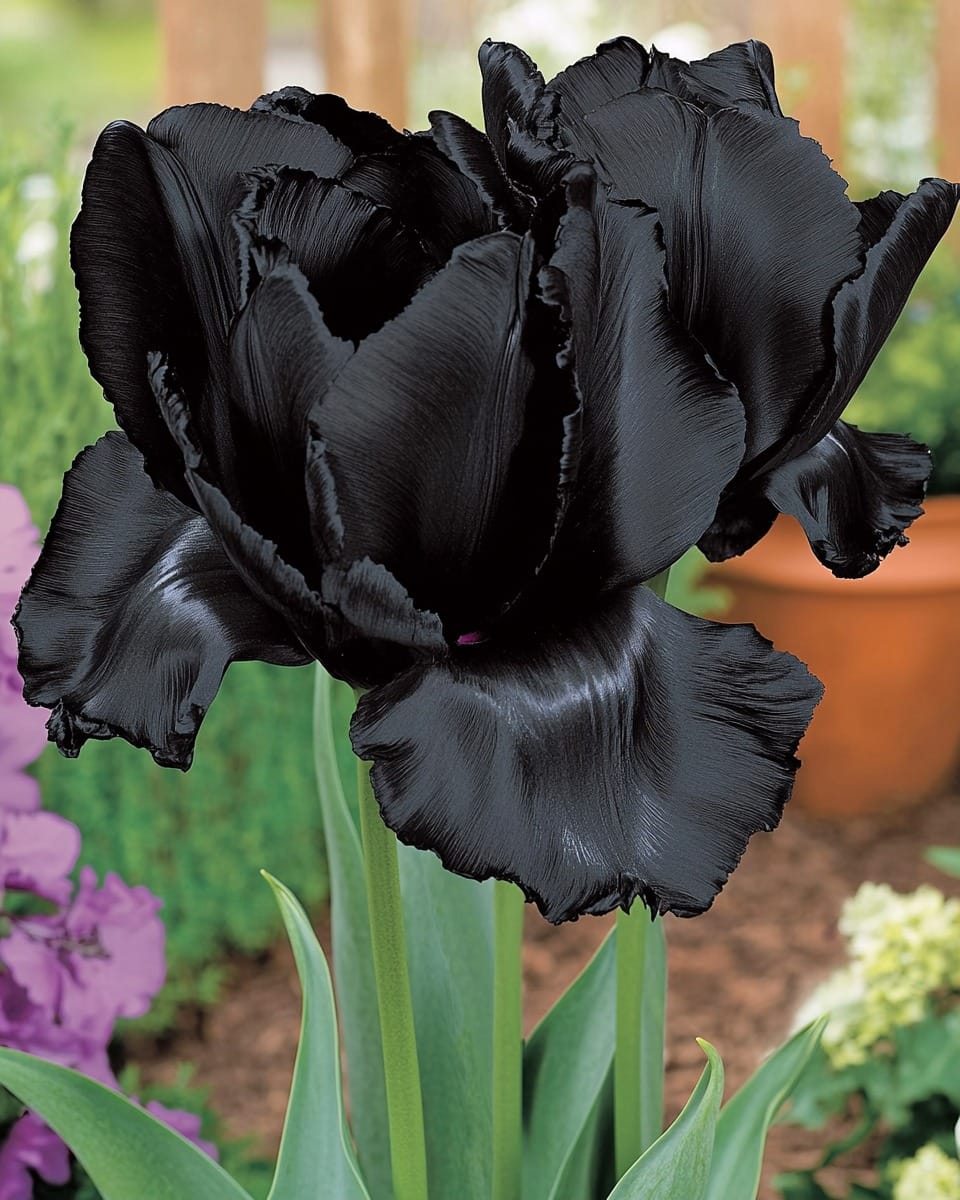The Black Parrot Tulip is a captivating flower, recognized for its dark, ruffled petals and its unique, feathery appearance. This striking tulip variety brings an air of elegance and drama to any garden or floral arrangement. Its rich, deep purple to black color creates a dramatic contrast against other spring blooms, making it an eye-catching centerpiece in garden beds, borders, and floral displays. The intricate, fringed petals add an exotic and sophisticated touch to any garden, especially in the cooler months of spring.
Light Requirements:
The Black Parrot Tulip thrives in full sun to partial shade. While it performs best in direct sunlight, it can tolerate some shade, making it versatile for different planting situations. A location that receives at least 4-6 hours of sunlight a day is ideal for promoting healthy growth and enhancing the rich color of the petals. Proper light exposure encourages sturdy stems and vibrant flowers, making this tulip a striking addition to any garden or floral display.
Watering Needs:
This tulip variety prefers moderate watering, with the soil kept moist but not overly saturated. Water the tulips regularly but allow the soil to dry slightly between waterings to avoid waterlogged conditions that could lead to root rot. Tulips are typically more vulnerable to over-watering, so ensure that the soil has good drainage. During the blooming period, ensure the soil stays moist enough to support the flower’s development, but avoid soaking it too much, as excessive moisture can harm the plant.
Soil Preferences:
For the Black Parrot Tulip, well-draining, fertile soil is essential. These tulips grow best in soil that is rich in organic matter, allowing for good root growth and moisture retention. Ideally, the soil should be slightly sandy or loamy, with a pH range of 6.0 to 7.0. Make sure the planting site offers excellent drainage to prevent any water from collecting around the bulbs, which could lead to rot. Mixing in compost or organic material can help enhance the fertility and drainage of the soil, creating optimal conditions for growing healthy tulips.
Temperature Tolerance:
The Black Parrot Tulip thrives in cool to temperate climates. It prefers mild temperatures, typically between 50-60°F (10-15°C). While tulips are hardy and can tolerate light frosts, extreme cold can damage the flowers. Therefore, this tulip variety is well-suited for regions with cool spring temperatures. In areas where the weather becomes too hot too quickly, the tulips may bloom prematurely or wither before reaching their full potential. However, in cooler regions, they will thrive, offering their dramatic blooms throughout the spring season.
Fertilization:
For best results, apply a bulb fertilizer specifically designed for tulips and other spring bulbs. These fertilizers are usually high in phosphorus, which encourages strong root development and promotes vibrant blooms. Apply the fertilizer when planting the bulbs in the fall, and again in the spring as the shoots begin to emerge. Be sure to follow the recommended application rates to avoid over-fertilizing, as this can lead to excessive foliage growth at the expense of blooms.
Ideal Planting Time:
Black Parrot Tulips should be planted in the fall, typically 6-8 weeks before the first expected frost. This allows the bulbs to establish roots before winter sets in, ensuring a strong start in the spring. Plant the bulbs about 6-8 inches deep and space them about 4-6 inches apart. Tulips generally require a period of cold dormancy, which helps trigger their blooming cycle once the temperatures warm up in the spring.
Design Tips:
The Black Parrot Tulip adds drama and elegance to any garden. Use it as a focal point in garden beds or plant it in groups to create a stunning visual display. Its dark, luxurious color contrasts beautifully with lighter blooms such as white, pink, or yellow tulips, daffodils, or hyacinths. The fringed petals of the Black Parrot Tulip also make it a perfect choice for floral arrangements. Pairing it with other rich, jewel-toned flowers or with delicate white blooms can create a striking contrast that highlights the beauty of its unique petals.
Conclusion:
The Black Parrot Tulip is a stunning and dramatic addition to any garden. With its ruffled, feather-like petals and deep, mysterious color, it provides an exotic flair to springtime gardens and floral arrangements. By following its care requirements of full sun, well-draining soil, and moderate watering, this tulip will reward you with breathtaking, elegant blooms year after year. Whether you’re growing it for garden beauty or as a cut flower, the Black Parrot Tulip will undoubtedly make a bold statement in any setting. 🌷
More Recipes You Might Like
-
Texas Toast Sloppy Joes: The Crunchy, Cheesy Upgrade You Didn’t Know You Needed
There’s something timeless about sloppy joes. For generations, this saucy, savory, and slightly sweet ground beef sandwich has been a go-to comfort food in American kitchens. It’s quick, filling, and family-friendly—perfect for busy weeknights. But what if we told you there’s a way to take this classic dish up a notch? Enter the Texas Toast…
-
Classic Pig Pickin’ Cake
When it comes to Southern desserts, few sweets shine as brightly as the Classic Pig Pickin’ Cake. This nostalgic cake, sometimes called a “Mandarin Orange Cake,” has roots deep in Southern tradition. It gets its playful name from its frequent appearance at pig pickin’s—Southern-style barbecue gatherings where communities come together to enjoy slow-cooked pork, sides,…
-
Lemon Garlic Butter Chicken with Creamy Parmesan Pasta
There’s something irresistible about the combination of tender, golden-browned chicken paired with a creamy pasta coated in Parmesan cheese. Add the brightness of lemon, the depth of garlic, and the richness of butter, and you have a recipe that feels indulgent yet approachable enough for a weeknight dinner. Lemon Garlic Butter Chicken with Creamy Parmesan…



